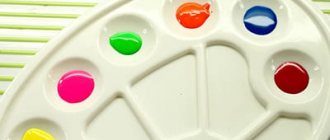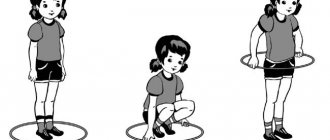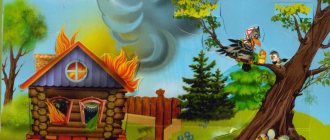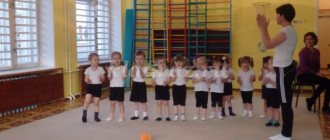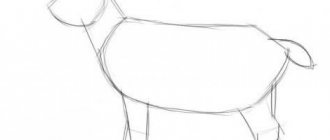Fun workout
Outdoor games strengthen the muscles of the child’s body, prevent flat feet, develop coordination of movement, and contribute to the development of motor skills and speech.
Types of outdoor games:
- different types of walking (side step, walking on heels, toes);
- climbing, overcoming obstacles;
- ball games;
- balance exercises (sliding down a hill, walking on an inclined bench).
Tests to determine pathologies
To quickly respond to changes in the baby’s development, you can conduct simple tests.
- By the fourth year, children can already distinguish the simplest geometric shapes. You need to ask the child to draw a circle. Even the similarity of this figure is a good result. However, if the child does not understand what is wanted from him, or his drawing does not even remotely resemble what is required, the test has not been passed.
- If a child does not show interest in new games and does not assemble a small tower from cubes, development is slow.
- By the age of three, the toddler communicates in short phrases (those who at this age already speak in long sentences are not taken into account). The minimum milestone for speech development by 3-4 years is the simplest phrases. If the child does not pronounce them, you should go to a specialist.
In what cases is it still necessary to contact a speech therapist:
- The baby does not respond to his name and does not understand simple requests.
- Shows no interest in new toys; all his game scenarios follow the pattern.
- He cannot assemble a simple turret or put a large bead on a rope.
- If by the age of three the child does not speak, there were injuries during pregnancy or early development, or there are hereditary diseases.
9.A lot or a little?
Goal: to teach children to correlate the words “one”, “many”, “few” with the corresponding number of objects. Materials: in this game you can use small toys - cubes, sticks, balls, etc. Progress of the game: When forming the concepts of “one”, “many”, “few”, it is useful to teach children to use the appropriate gestures: “one” - show the index finger; “a lot” - a wide, circling hand gesture; “little” - a narrow, outward gesture with the hand, or fold your palms into a handful. To do this, the speech therapist constantly uses these gestures and encourages children to use them. The names of concepts should be highlighted in speech. The game is played on the carpet. Lay out the cubes in front of the children: one pile has a lot of cubes, and the other has few. Look, here are the cubes, and here are the cubes too. There are a lot of cubes here (the speech therapist shows the corresponding gesture), but there are few cubes here (the speech therapist shows the corresponding gesture). Show where there are few cubes. How do you show that there are not enough cubes? (the speech therapist encourages the children to show a gesture) Where are there a lot of blocks? How do you show that there are a lot of cubes? (the speech therapist encourages the children to show a gesture) And here is one cube. (the speech therapist shows the appropriate gesture) Take one cube at a time. Show that there is only one cube. (the speech therapist encourages the children to show a gesture) It is useful to repeat this game using different subject material.
The first session of a speech therapist with a child: where to start
Speech therapy classes are carried out for the following purposes:
- Understanding native speech, observing and comprehending everything that happens around. This is how the child learns about the world around him. The speech therapist forms general concepts, gives the basics of word formation, and teaches how to use complex phrases.
- Formation of correct pronunciation of words and development of phonemic hearing. Monitoring the clarity and expressiveness of speech.
- Teaching independent speech using different sentences.
Many people are interested in how the first speech therapist session is conducted. The first session of a speech therapist with a child, where to start:
- The child's disposition towards himself.
- Carrying out diagnostics and identifying problems.
- Introduction to the speech apparatus.
- Teaching simple speech therapy exercises and games.
- Building a work plan.
Literature to help the speech therapist: Fadeeva Yu. A., Pichugina G. A., “Speech therapy classes in the younger group”
The abstract by Fadeeva and Pichugina is intended for speech therapy classes in the younger group. It promotes the formation of speech skills in children two to three years old who have various speech problems of different etiologies. It is intended for speech therapists, speech pathologists, educators and parents.
Stages of working on a new word in speech therapy
Stages of working on a new word in speech therapy:
- Determining the relationship between a sound word and a visual, auditory and other image.
- Analysis of word composition.
- Identification of semantic features of a word.
- Introduction of a word into the semantic field.
- Consolidating the meaning of a word.
How to recognize disorders and when to contact a speech therapist?
The list presented above is general in nature, but if at least three points from it are not characteristic of a child’s speech behavior, this is a reason to think about it.
Here are some signs that may indicate a delay in your child's speech development:
- the pace of his speech is uneven - he sometimes speaks too quickly, sometimes he drawls out his words;
- speaks unintelligibly, only his mother understands him;
- if he speaks in phrases, then not his own, but only those he heard from adults or on TV;
- he himself has difficulty understanding what adults tell him;
- mouth constantly open, like a limp mouth;
- increased salivation not associated with teething.
If one or more signs from this list are present, it is advisable to diagnose the child’s speech development. Perhaps there really is a pathological disorder that requires special treatment, or perhaps the baby just needs speech therapy exercises. But before contacting a speech therapist, you need to show the child to a neurologist, psychiatrist and speech pathologist: they will help determine whether the delay in speech development is associated with disorders of the central nervous system or the problem is only in the pronunciation of sounds. You may also need the help of an audiologist - a specialist who identifies hearing defects. If doctors have not found any physiological reasons for the development of mental retardation, then the child will benefit from sessions with a speech therapist.
How to conduct a speech therapy session at home for children 2-3 years old
At two or three years old, the baby cannot sit in one place for a long time. It is better to conduct classes with him only when the baby himself wants.
Important! First of all, it is necessary to establish emotional contact with the baby.
As home exercises for speech development, you can use finger games: you need to put your index finger and thumb together. Leave the remaining fingers straight. It is worth showing the children this cockerel and saying: “Peter the Cockerel, the golden comb, went to the market and bought a boot.”
Games for kids on onomatopoeia
To study sounds and syllables, you can use exercises to imitate the sounds of animals and objects. You can say the following words in a row with your baby:
- the pig repeats: “oink-oink, I’ll give you a liver”;
- a steam locomotive travels around the world and says: “too-too, I’m going”;
- the hare eats carrots with appetite and makes noise: “crunch-crunch”;
- the rain keeps repeating: “drip-drip, you need to take an umbrella with you.”
Developing hearing
Special games are used to train phonemic hearing. Examples of games:
- The child picks up two flags of different colors. For example, green and yellow. It is necessary to explain to the child that when a word is pronounced correctly, a green flag must be raised, and when a word is pronounced incorrectly, a red flag must be raised. For example: dog - tavern - lobaka, etc.;
- You can use pictures. The kid should clap his hands when he sees words in the picture that sound similar.
- Playing teacher. You need to read a fairy tale and intentionally make mistakes in it. The child must correct the adult.
Articulation gymnastics exercises for speech development in children 2-3 years old
During speech therapy classes at home, it is necessary to develop the muscles of the tongue. For this purpose, articulatory gymnastics is used. It is performed in front of a mirror. Exercises:
- the child imagines that the tongue is a brush. The mouth is slightly open. The tongue must be drawn across the palate towards the throat and back;
- mouth open wide. The tongue is located under the lower teeth. Raise the tip of the tongue under the upper teeth and lower it back;
- tongue cleans teeth. The mouth is wide open. First, the tongue passes over the lower teeth, and then over the upper teeth.
We teach you to pronounce hissing sounds using the methods of Fomicheva and Bogomolova
Replenishing vocabulary: learning poems and tongue twisters
Reading tongue twisters and poems helps to form beautiful and correct speech. They learn to pronounce letters without skipping or swallowing them.
Important! Particular attention should be paid to tongue twisters starting with the letter “P” and hissing ones.
Tongue Twisters:
- Grass in the yard, firewood on the grass.
- Karl stole corals from Clara, Clara stole a clarinet from Karl.
Characteristics of the development of a 3-4 year old child
At 3 years old, the child is open to learning his native language, he happily repeats everything after an adult and is actively engaged in word formation. By the age of 4, the passive vocabulary reaches 2,500 words, most of which are verbs and nouns.
The child’s speech also contains:
- simple adjectives (beautiful, small, big);
- possessive pronouns (my);
- generalization words (animals, vegetables).
A preschooler does not yet have much life experience and produces new words in his own way. This gives rise to curious word forms, for example: “Mom is studying, but I am a lazybones.” A three-year-old child is able to maintain a simple dialogue.
The most difficult sounds to pronounce are “R” and “L”, as well as the whistling “Sh”, “S”, “F”. Often, even after reaching four years of age, the child is not able to pronounce them.
Important! If at 3-4 years old a child does not pronounce all sounds clearly, this is not a reason to run to a speech therapist. The sounds “R”, “L”, “Sh”, “S”, “F” are usually introduced at a later age. However, if by the age of 3 the baby does not speak at all, and there were serious illnesses or injuries during pregnancy/birth/in the first year, consultation with specialists is required. Based on the results of the examinations, a psychologist, speech therapist and neurologist will tell you what speech therapy exercises for children 3-4 years old should be performed.
Speech therapy exercises for children 2-3 years old
In the second or third year, you can do special speech therapy exercises with your child at home. They develop movements of the lips, tongue and lower jaw. They help strengthen the muscles of the articulatory organs, due to which the appearance of sounds occurs faster. All exercises are performed in front of a mirror.
You can do the following tasks at home:
- bursting of the bubble: the cheeks are inflated as much as possible. Press your palm first on one cheek and then on the other;
- wide smile: lips are drawn out, then you need to smile widely, showing your teeth;
- show your tongue: you need to quickly stick out your tongue and then remove it.
Speech therapy songs for children 2-3 years old
Speech therapy songs for children 2-3 years old are aimed at automating sounds and clarity of speech. The lyrics and notes of the songs interest children and create a joyful and favorable mood for them. The baby sings along with pleasure, and the activity takes on a cheerful and unobtrusive atmosphere. To conduct classes at home, just download online collections of songs from the Internet.
Innovative speech therapy technologies: syncwine
